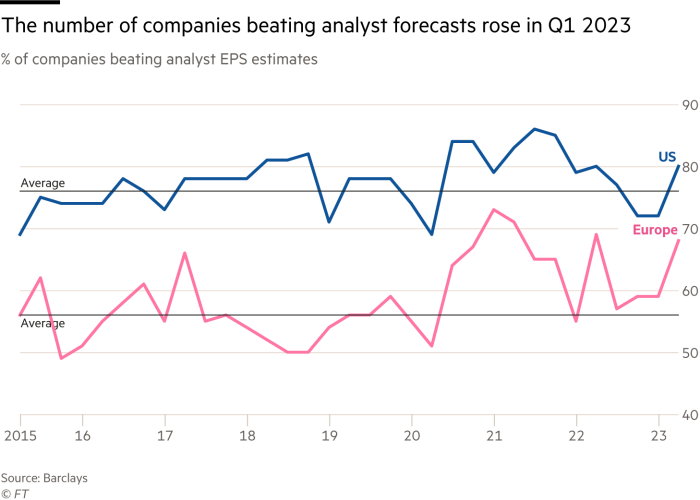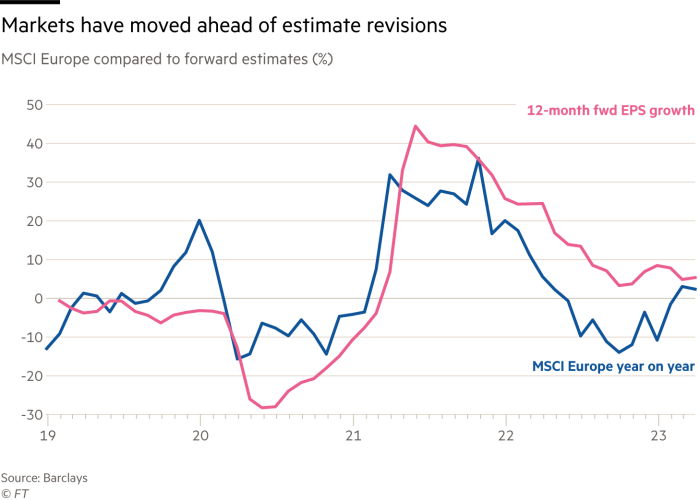How to demystify the market prophets

Roula Khalaf, Editor of the FT, selects her favourite stories in this weekly newsletter.
Sales and profits forecasts from City analysts play an important role in determining share prices. These estimates are available to professional investors via specialist electronic databases offered by Bloomberg, Refinitiv and others.
As a rule, companies that perform better than expectations see their stock prices rise and companies that miss them suffer. On Wednesday Siemens, the €126bn German industrial conglomerate, lifted its sales and profits outlook for the fiscal year ending in September 2023. It now expects to make earnings per share of up to €9.90, compared with €5.47 last year. Its share price duly jumped.
But this behaviour does not always hold. It can be a bad idea to take these projections at face value. Streetwise private investors know there is an art to reading them. More to the point, the aggregate of such estimates may not be an accurate predictor of how the market as a whole is likely to do.
For a neat example of why relying on published estimates is not always a good strategy, look no further than the first quarter of 2023. A quick glance at reported numbers and you would be justified in thinking that companies performed much better than the market expected — and that share prices might pop. Not so.
First-quarter earnings beat analysts’ forecasts by 14 per cent on average, according to Deutsche Bank. Companies also sounded sanguine about the future. A Barclays analysis of conference-call transcripts noted that 70 per cent of companies see profit margins holding or even expanding.
Yet all of these positive surprises failed to give the markets much impetus. Both the S&P 500 and the Euro Stoxx 600 index are trading roughly where they were in February, before the brief banking sector-related wobble.
That suggests that cannier investors had already applied a healthy dose of scepticism to analyst forecasts. And, indeed, it is not hard to see why they might have done so.
In aggregate, analysts had been expecting a 12 per cent decline in first-quarter profits compared with the first quarter of last year. Yet resilient macroeconomic data has long suggested this might be overly gloomy. Energy costs throughout Europe have been retreating, with natural gas not far from two-year lows. UK GDP numbers showed a better performance than feared. Recent purchasing manager index releases for Europe have revealed a rising trend of confidence.

Top-down macro mood music provided a more useful indicator of the earnings consensus from bottom-up analysis. That points to some of the reasons why analyst estimates, while important, are imperfect.
Analysts can be late to the party, often publishing estimates only once a quarter or so. At any given time, the consensus reflects a mix of updated and older numbers. Moreover, analysts tend to focus — in detail — on near-term estimates. Medium-term outlooks — on which sensible investors should focus — can be roughly hewn.
Secondly, taking all analyst estimates in aggregate can give a misleading view of the market as a whole. Adding up all company forecasts overshoots GDP growth by some margin, suggests an analysis of the US stock market carried out by Verdad.

Nevertheless, analysts do provide a useful service, especially when looking at individual companies. Listed groups want to be well understood by the market, and guide the analyst community on how to model future trends. The best of the analysts can use this understanding to pick out stocks that will outperform, relative to the rest, according to a study by Hemang Desai and others for the Financial Analyst Journal.
But the lesson for investors is that, as a broader gauge of where markets are heading, published estimates should be taken with a shovelful of salt.
______
Vodafone: Margherita’s recipe
What analysts do understand well is how much a company’s assets might be worth. In Vodafone’s case, they reckon that the value of the constituent parts exceeds the telecom’s group market capitalisation by some margin. This suggests the group’s new chief executive, Margherita della Valle, will come under pressure to put them on the block.
That does not appear to be her plan. Della Valle’s latest turnround is a pragmatic response to competitive weakness. But it is unlikely to deliver anything like the group’s value on a sum of the parts basis. That helps explain why the market dialled down Vodafone’s shares by 7 per cent when the plan was revealed on Tuesday.
Vodafone operates in a horribly competitive European market and has an accompanying tendency to use its foot for target practice. It has stumbled in Spain and — in spectacular fashion — in Germany, its largest market, where it is losing broadband customers.
Revenues have been broadly flat for at least a decade. Returns lurk below or around cost of capital in four key markets. Vodafone’s free cash flow does not cover capex and shareholder returns, although disposals are bringing leverage down. The shares have fallen more than half over the past five years.
Remedies are scarce. Della Valle vows to improve Vodafone’s performance by slimming down headquarters and devolving power and accountability to operating subsidiaries. The company is cutting more than 10 per cent of its workforce. It will reinvest savings in a better customer experience, supposedly. It plans to chase higher-margin business clients, who value its brand.
This is sensible, but does not amount to a strategy to replace Vodafone’s failed push for scale advantages.
Ex-finance boss Della Valle deserves credit for putting Spanish assets on the block. She is open to other changes in the group’s structure. She should pursue this line of reasoning. Vodafone’s market capitalisation is £23bn. That is a discount of almost 30 per cent to a sum of the parts valuation from Citigroup.
Vodafone cannot afford to dally. Remaining investors, long kept on hold, need little excuse to disconnect. Pressure for a break-up will persist and intensify.
Comments